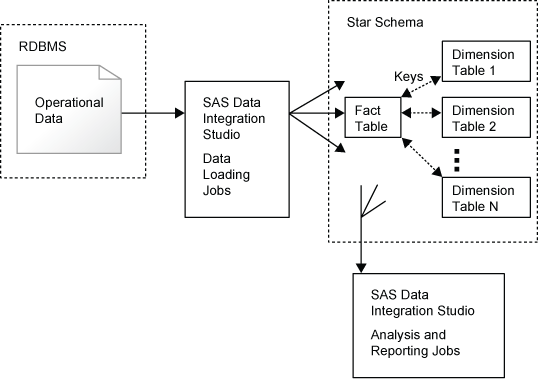About Slowly Changing Dimensions
Slowly Changing Dimensions Defined
Slowly changing dimensions
(SCD) is the name of a process that loads data into dimension tables.
This data changes slowly, rather than changing on a time-based, regular
schedule. The dimension tables are structured so that they retain
a history of changes to their data. This record of data changes provides
a basis for analysis.
As shown in the following
diagram, dimension tables combine with fact tables to form star schemas.
Fact tables store numeric events. Dimension tables store the detail
data that describes the events. Key columns in the tables connect
events to details. For example, a star schema might store product
sales numbers in a fact table, and use dimension tables to store information
about customers, suppliers, and retail locations.
Types of Slowly Changing Dimensions
The three most
common types of slowly changing dimensions are defined as follows:
Type 1 SCD: no history of data changes
overwrites specified
columns in dimension tables without retaining a history of changes.
Type 1 SCD is useful for maintaining less-significant columns that
are not used in historical analysis. In SAS Data Integration Studio,
the SCD Type 1 Loader transformation performs Type 1 updates. You
can use the SCD Type 2 Loader transformation to combine Type 1 and
Type 2 updates in a single operation.
Type 2 SCD: full history of data changes
maintains multiple
records for each business key in the dimension table. The latest entry
is the current entry for that business key. Other rows comprise the
historical record of data changes. New entries create new current
rows. This comprehensive record of data changes is the primary purpose
of the SCD Type 2 Loader transformation.
Type 3 SCD: limited history of data changes
maintains a limited
history of changes using multiple columns for selected variables.
For example, a Type 3 dimension table containing customer information
has columns named New Postal Code, Old Postal Code, and Oldest Postal
Code. Data is moved from column to column during the loading process.
Type 3 SCD has less analytical value than Type 2 SCD.
Transformations That Support Slowly Changing Dimensions
SAS Data Integration Studio provides the following
transformations that you can use to implement slowly changing dimensions:
SCD Type 1 Loader
inserts new rows, updates
existing rows, and generates surrogate key values in a dimension table
without maintaining a history of data changes. Each business key is
represented by a single row in the dimension table.
SCD Type 2 Loader
inserts new and Type
2 rows, updates existing rows, and generates surrogate key values
in a dimension table. At the same, it maintains a full history of
data changes. Each business key is represented by a current row and
0 through n number of closed out rows. The closed out rows enable
change analysis over time.
Compare Tables
detects differences
between matching rows in specified columns in two tables. Outputs
include changed, new, unchanged, and missing records tables. These
outputs can be used as the basis for performing Type 1 or Type 2 updates
in a dimension table.
Lookup
loads source data into
fact tables and loads foreign keys from dimension tables, with configurable
exception handling. The lookup process accesses dimension tables by
using hash objects for optimal performance.
Copyright © SAS Institute Inc. All rights reserved.
